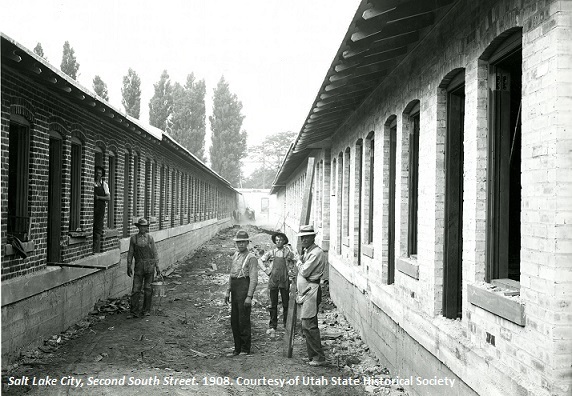Dublin Core
Title
Description
Salt Lake City’s Red Light District was the target of an unusual cleanup campaign in 1908.
Prostitution is known as "the world’s oldest profession," and was established in Utah by the 1850s. While laws made prostitution illegal, Salt Lake City officials often found it more practical to regulate the trade, rather than try to eliminate it.
By the 1870s, downtown’s Commercial Street was the center of Salt Lake’s “red-light” district, with saloons and parlor houses that accommodated “female boarders.” Police raided these establishments regularly to arrest these “female boarders.” But eventually a registration system evolved whereby the madams who ran these brothels provided the police a list of the women who worked for them. Each woman then paid a monthly fine of $10, a tidy arrangement that bolstered the City’s coffers.
By the turn of the Century, calls to clean up Commercial Street grew louder. In 1908, Salt Lake Mayor John Bransford decided to build a compound on the west side of town where prostitution could be more discrete and better regulated. Bransford invited Mrs. Dora Topham, a notorious Ogden madam known as “Belle London," to take charge of the new enterprise. The block between 5th and 6th West and 1st and 2nd South was chosen for construction of “The Stockade,” which consisted of 100 small brick "cribs" built in rows that surrounded six larger parlor houses. The Stockade entrances were guarded to keep out children and "undesirable" guests. Women paid rent of $1-$4 per day and were prohibited from doing business elsewhere in the city.
The Stockade opened on December 18, 1908. The neighbors hated it, and the West Side Citizen's League was formed to abolish it. But the Stockade operated for three years until Belle London herself called it quits. The “bordello village” was pulled down, and many of the so-called “scarlet ladies” returned to Commercial Street, which was a red-light district into the 1930s. Others stayed in the neighborhood of West 200 South, which remained an area for prostitution until the 1970s.
Creator
Source
_______________
See Hal Schindler, “The Oldest Profession's Sordid Past in Utah,” Salt Lake Tribune, 1997; Jami Balls, “History of the Stockade and Salt Lake's Red Light District,” History Blazer; John S. McCormick, "Red Lights in Zion: Salt Lake City's Stockade, 1908-1911", Utah Historical Quarterly, volume 50, number 2, 1982.

